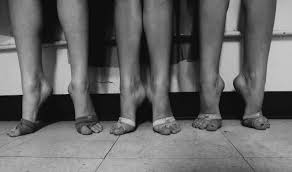
Human movement is deeply rooted in our foot function. The foundation to achieving optimal foot function is to first understand your foot type. Below you will find a short Foot Type Quiz to help you better determine your foot type, as well as the subtle differences between foot types – namely with flat feet.
Foot Type Quiz
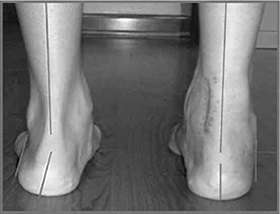 1. Stand with your feet shoulder width apart with your feet parallel and your heels directly behind your toes.
1. Stand with your feet shoulder width apart with your feet parallel and your heels directly behind your toes.
Using a camera or video capture the back of you heels like the image to the right. Make sure that the camera is perpendicular to the floor and is directly behind your feet.
When assessing the picture do you see a concavity on the inside of your ankle bone? This means inversion
Do you see concavity on the outside of the ankle? This means eversion
Or do you see that the foot is pretty straight in line with no concavity on either side? This means neutral
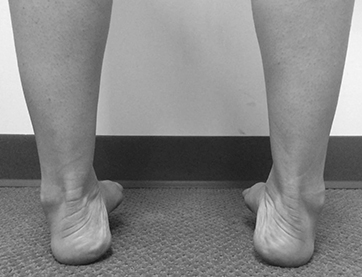
Inverted Foot

Neutral Foot

Everted Foot
What does this mean?
 If you have an inverted foot it means that your foot is more rigid than a neutral foot but more stable than an everted foot. We need a little flexiblity in our feet in order to take load or impact. If you have an inverted foot you are more susceptible to stress fractures, Achilles tendonitis and plantar fasciitis. To increase mobility in your foot you should focus on daily foot recovery by standing on a golf ball or tennis ball as well as with daily calf stretching.
If you have an inverted foot it means that your foot is more rigid than a neutral foot but more stable than an everted foot. We need a little flexiblity in our feet in order to take load or impact. If you have an inverted foot you are more susceptible to stress fractures, Achilles tendonitis and plantar fasciitis. To increase mobility in your foot you should focus on daily foot recovery by standing on a golf ball or tennis ball as well as with daily calf stretching.
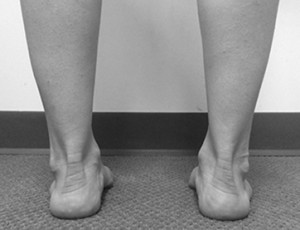 If you have a neutral foot you are balanced between your foot acting as a rigid lever and a mobile adaptor. This is the ideal foot position as it allows the foot to lock and unlock with every step you take. Having a neutral foot does not mean you are free of risk of injury. You still must integrate daily foot recovery such as standing on a golf ball or tennis ball for 5 minutes twice a day.
If you have a neutral foot you are balanced between your foot acting as a rigid lever and a mobile adaptor. This is the ideal foot position as it allows the foot to lock and unlock with every step you take. Having a neutral foot does not mean you are free of risk of injury. You still must integrate daily foot recovery such as standing on a golf ball or tennis ball for 5 minutes twice a day.
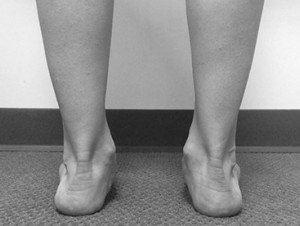 If you have an everted foot this means your foot is more flexible and unstable than a neutral foot. Although some foot flexibilty is important to function, having too much can increase the risk of injury. To build more stability in the foot you want to focus on daily foot strengthening with short foot exercise and balance training. Depending on the severity of eversion you may or may not be a candidate for orthotics.
If you have an everted foot this means your foot is more flexible and unstable than a neutral foot. Although some foot flexibilty is important to function, having too much can increase the risk of injury. To build more stability in the foot you want to focus on daily foot strengthening with short foot exercise and balance training. Depending on the severity of eversion you may or may not be a candidate for orthotics.
Yes. If you were able to neutralize the back of your foot in a single leg stance this means that your glutes are working sufficiently to help control your foot posture or foundation during a single leg stance. This translates to walking and our stability during the midstance phase of gait.
No. If you were not able to neutralize the back of the foot in a single leg stance this means that there is a greater instability or weakness present. Glute strengthening is definately something you will want to focus on as the glutes play a big role in foot control and stability. Some of the best glute exercises include single leg balance exercises.
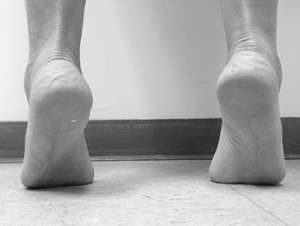 3. Standing next to a wall or chair, stand with your feet shoulder width apart with the feet parallel. Shift your body weight so you are now standing on one leg. Stay on the one leg and rise onto the ball of the foot into a single heel rise.
3. Standing next to a wall or chair, stand with your feet shoulder width apart with the feet parallel. Shift your body weight so you are now standing on one leg. Stay on the one leg and rise onto the ball of the foot into a single heel rise.
Do you notice if the heel shifts into an inverted position? Reference the picture to the right.
Do you have any pain when rising onto a single heel rise?
What does this mean?
If you were able to rise into a single heel rise with no pain and with inversion of the heel then you have adequate strength in the foot to become a rigid lever or stable for push-off.
 If you had difficulty coming onto a single heel rise, had pain or noticed that the heel did not invert then you have weakness in your posterior tibialis muscle. Weakness in the posterior tibialis not only makes it difficult to lift onto the ball of the foot but it also decreases stability in the medial arch and can cause a flat foot. To build strength to posterior tibialis begin to strengthen the foot by doing daily short foot exercise as well as heel lifts with a tennis ball between the heels. Reference the picture to the right.
If you had difficulty coming onto a single heel rise, had pain or noticed that the heel did not invert then you have weakness in your posterior tibialis muscle. Weakness in the posterior tibialis not only makes it difficult to lift onto the ball of the foot but it also decreases stability in the medial arch and can cause a flat foot. To build strength to posterior tibialis begin to strengthen the foot by doing daily short foot exercise as well as heel lifts with a tennis ball between the heels. Reference the picture to the right.
Do you see an arch? Or does the arch drop down?

High Arch

Neutral Arch

Low Arch
What does this mean?